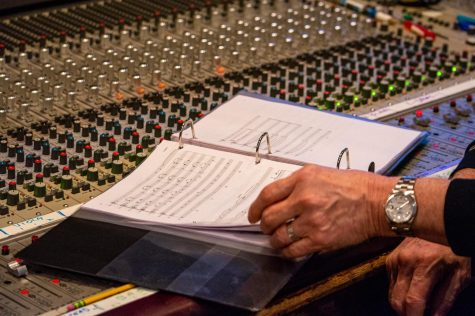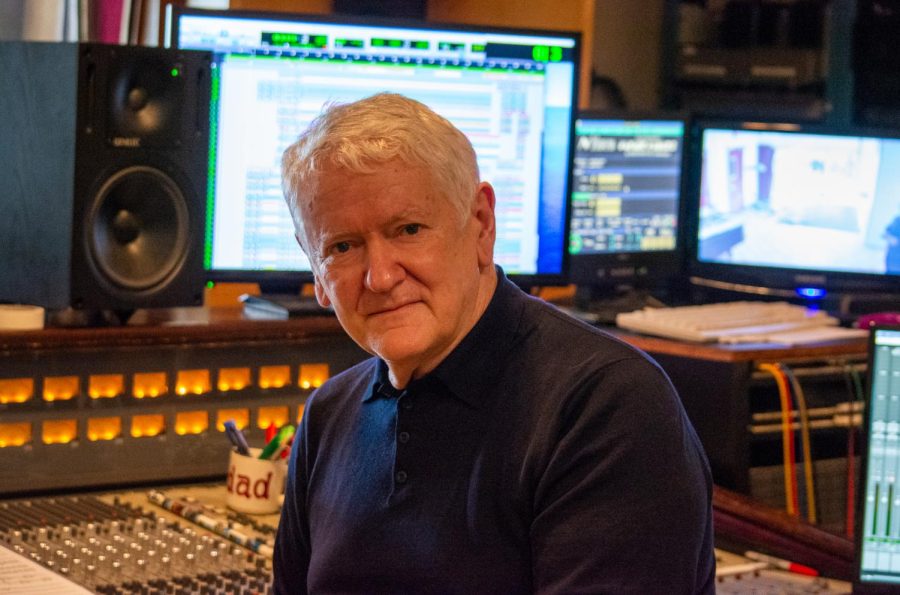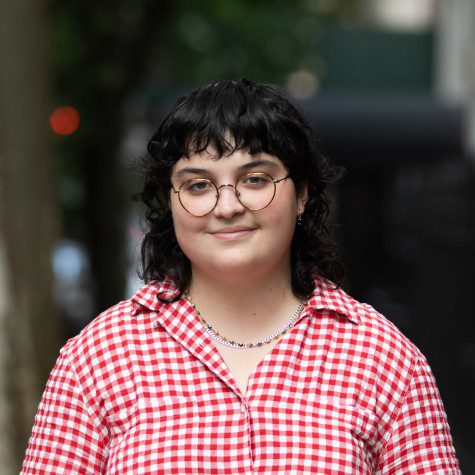With 28 Grammy nominations, Tisch prof. Jim Anderson can’t be stopped
The recording engineer and producer maintains a busy professional life while working as a professor at the Clive Davis Institute of Recorded Music.
Founder of the Clive Davis Institute of Recorded Music, Jim Anderson is a 28-time Grammy and Latin Grammy nominee, with 11 of those being wins. He is currently nominated for Best Immersive Audio Album for his work on the Patricia Barber album “Clique.” (Staff Photo by Manasa Gudavalli)
April 1, 2022
As a college student, it’s pretty rare that you can say that your professor has been nominated for a Grammy. Now try 28. That’s how many nominations Jim Anderson has under his belt from the Grammy and Latin Grammy Awards — with 11 of those being wins.
This year, the Clive Davis Institute of Recorded Music professor is nominated for best immersive audio album for his work on the Patricia Barber album “Clique.” While working on the album, he and his wife, Ulrike Schwarz, were one of the first to use a new high-resolution digital audio format called Digital eXtreme Definition.
This isn’t the only time Anderson has been at the forefront of the music world — he was part of the founding faculty of Clive Davis, one of the first programs of its kind when founded in 2003. After nearly 20 years at NYU, Anderson spoke with WSN about the Grammys, his professional life and his work as a professor.
On 28 Grammy nominations
Should Anderson win on April 3, it’d be his second Grammy Award with Patricia Barber. When asked how he felt about it, he responded, “I like the idea that the work is getting recognition and it’s good enough to stand on the same platform.”
“Clique” is up against pop albums by Harry Styles and Alicia Keys, as well as some classical pieces, so Anderson isn’t 100% confident. But if you check out his track record, the odds look pretty good.
In 2013, he submitted his first surround sound album for Grammy consideration, which was Patricia Barber’s “Modern Cool.” The album won that year. Then, in 2018, Anderson won again with Jane Ira Bloom’s “Early Americans.” He’ll admit he’s had “pretty good luck” in the immersive audio category.
On selecting songs for “Clique”
“Clique” started when Anderson and Barber had just finished a different project. Barber had asked what they were doing, to which Anderson responded suggesting they record some music she liked.
“The band huddled in the corner for about half an hour and came up with a list of tunes,” he continued. “For the next two days, we just recorded — actually a day and a half — we did that whole record.”
From that point, Anderson and Barber whittled it down to nine songs that would make the final cut.
“Frankly, I don’t even think I mixed anything beyond that nine,” he recalled, noting that record companies are prone to releasing any music that’s been mixed, even if the tracks are less strong. “The fact is, if it’s an outtake, there’s a reason we didn’t put it on the record.”
On frequently working with Patricia Barber
Anderson and Barber met through another producer, who introduced the two to each other. The pair’s professional journey together had a bit of a false start, with their first project getting tangled in major label politics.
“One label ate up another label,” he said. “And the project just died. She lost her contract.”
They didn’t let that stop them, though. Upon signing with the Chicago label Premonition, Barber had one condition — Anderson should come from New York and work with her. The record they ended up working on, “Cafe Blue,” would become an “audiophile standard,” as Anderson described it.
While working with Barber, Anderson developed a specific routine in the studio. He strived to create a comfortable environment for her, so that she felt at ease and nothing would compromise her performance. To achieve this, he had the band come in a couple of hours before Barber’s arrival, ensuring that everything was set up and sounded good before she got there.
“A singer is like a racehorse,” he said. “They can be jittery and skittish and you really don’t want to go in there and rock the boat … [this way] she doesn’t have to watch the sausage be made or anything like that.”
On recording in high-resolution
In the time he’s worked with Barber, Anderson has taken the opportunity to upgrade his recording process. To begin with, he used an Atari 32-track digital recorder, before shifting to a Sony 48-track. Both of these were digital multi-track recorders, which were used especially before the invention of digital audio workstations (DAWs). This is because digital multi-track recorders allowed engineers to overdub tracks, which had previously not been possible with analog tape recording.
“Then we moved up to ProTools and now we’ve moved up to this format,” Anderson said. “This 352.8 kHz with a 32-bit floating point and that kind of crazy stuff.”
Most professional audio recordings use a 48 kHz sampling rate and CD recordings use a 16-bit depth. With higher sampling rates and bit depths, you get a closer recreation of the original audio, leading to higher-resolution recordings.
Anderson and Schwarz were some of the first engineers to use this method and were excited to see the results — though they had a lower-resolution backup just in case.
“We went to Skywalker [Sound], opened up the faders and when we heard her voice for the first time in a super high resolution, you just knew it was a huge difference,” he said. “It was leaps and bounds beyond what we’ve done.”

On being a good recording engineer
“Engineering is really paying attention to detail,” Anderson said. “That’s everything from mic placement to mic cables to preamplifiers, and then you have to be sort of an artist in mixing.”
On Digital eXtreme Definition’s future in pop music
“I think if you had some artists who were really concerned about quality — like a Neil Young or something like that — that kind of artist would go in that direction,” Andersen said. “I think it would take a special artist to come along and say, ‘Oh, I want to work in that format.’ [But] I’m hoping that somebody will hear what we’ve done and say, ‘Hey, let’s work with those folks.’”
On the format’s viability at Clive Davis and student interest in audio engineering
“We’d have to completely replace the entire recording system for a studio,” Anderson said. “So I don’t think they’re going to do that.”
Yeah, probably not.
“There aren’t many students at Clive that are interested particularly in engineering,” he said. “When I have an advanced engineering class or I have an immersive mixing class, I can count on maybe six students from the entire population coming in. Which doesn’t surprise me, because you really have to have a technical bent, a technical direction you’d like to go.”
On balancing a professional career with teaching
“One thing about Tisch is [that] all of the professors are expected to have a professional life, regardless of what it is that you do,” Anderson said. “So it’s a great situation to know that all the faculty are very much professional colleagues.”
He went on to explain that he’s always had a schedule — even when he was a kid — and that not working seven days a week is his version of a nightmare.
“If I’m not busy, I try to find ways to become busy,” he said.
As a professor at Clive Davis, Anderson also feels he needs to inspire students — “otherwise what are we doing there?” he said. “We’re just kind of reinventing the wheel. So it’s great to be able to get out there and work.”
On founding the Clive Davis Institute
When Anderson went to college, it was to get a degree in music education. But after graduating, he realized he didn’t want to teach, and instead embarked on a purely professional life from 1973 until 2003, when Clive Davis was founded.
“When they were looking for faculty at Clive, they needed a production person,” he explained. “They were looking for somebody that had [a] music background and [an] education background. They either found music people or they found education people, [but] they didn’t find a balance of that.”
That is, until Anderson entered the picture.
“When I walked in, I had 30 years of working in the music industry and an education degree, so [I’d] actually been to college to learn how to teach,” he said.
Hired in May 2003, Anderson had roughly three months to come up with a plan for the start of the school year in September. Clive Davis’ goal was to teach college-level recorded music differently, meaning Anderson had to think outside the box. He decided they needed to teach analog recording in a completely new way, so that it wasn’t as daunting for incoming students. In the students’ first year — assuming they had used other DAWs, like GarageBand or FL Studio — they would learn ProTools, the professional standard for DAWs. Only in their second year would students tackle gear like tape machines.
“At the time, this was really radical to do,” Anderson said.
On learning from students
“My wife always says to me, ‘Your mixes sound younger and fresher than some of your colleagues’,” Anderson said. “That’s because I’m hanging out with you guys and I’m hearing the material that you guys are doing … So I don’t fall behind and keep on making the same old records.”
“I think that’s probably the best thing that really happens to me being a part of Clive,” he added.
On new projects
“We were just talking yesterday with an artist who is interested in having us come in and mix their project in immersive,” Anderson said. “So we are really excited about that … It’s an artist I’ve always wanted to work with.”
Patricia Barber’s album, “Clique,” is available on all streaming platforms.
Contact Yas Akdag and Lillian Jones at [email protected].


























































































































































